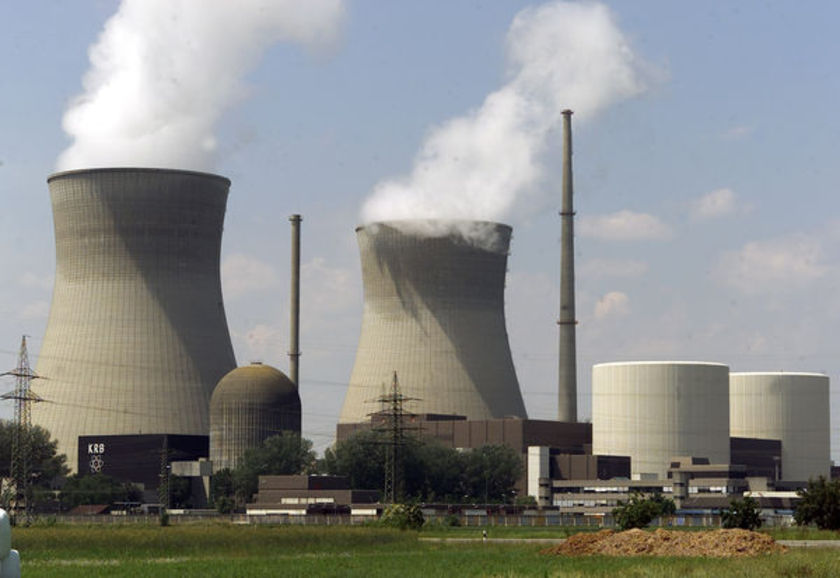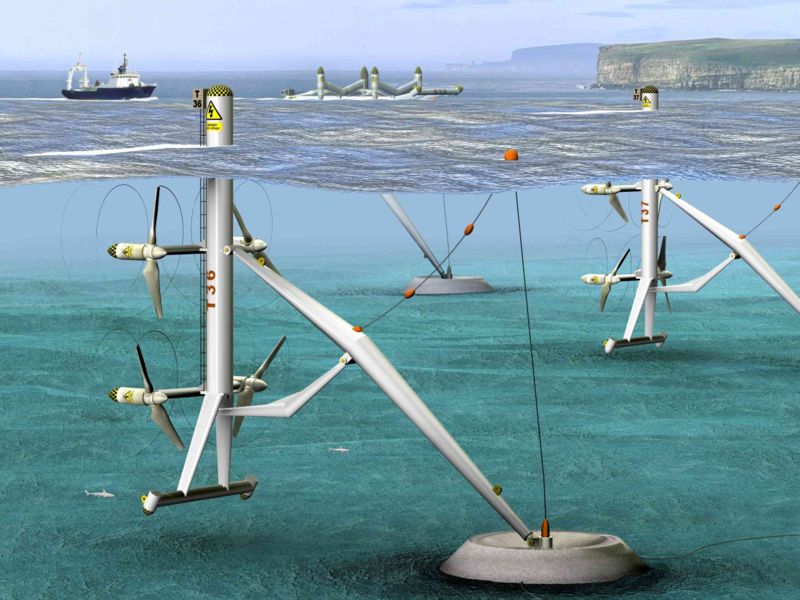Alternative Energies
Finding and implementing renewable energy sources is a critical element in preventing carbon dioxide (CO2) emissions and lowering global carbon concentrations. Using a variety of technologies such as solar, wind, tidal, geothermal, and nuclear it is possible to eliminate many electricity sources that produce CO2 emissions. If all electricity sources were renewable worldwide, 40% of CO2 emissions would be prevented (World Bank, 2009). Another 20% of the global CO2 emissions come from the transportation sector, in which other alternative energies like biofuels and fuel cells could be implemented to reduce emissions (World Bank, 2009).
To decrease global CO2 concentrations in the atmosphere to 350ppm by the year 2110, renewable energies must be used to decrease the amount of CO2 produced.
Note that our plan focuses mainly on carbon capture and sequestration, so this section is designed mainly to illustrate the potential of alternative energies in decreasing global CO2 emissions. Our plan assumes that alternative energies will be able to significantly reduce global CO2 emissions, reducing the total amount of CO2 needed to be sequestered to reach our goal of 350 ppm.
Electricity Technologies
Geothermal
Geothermal energy produces electricity by transferring the heat of the Earth a transmission fluid, which then heats up and passes through a turbine. Most geothermal power plants use water as the transmission fluid, though it has been proposed that CO2 could be used as well and even be used as a means of storing CO2 (Pruess, 2007). On average, one CO2 powered geothermal power plant stores 3000 tonnes of carbon dioxide, while the average coal fired power plant emits 1000 tonnes per year (Pruess, 2007). Scientists estimate 500MW could be produced per year per CO2 powered geothermal plant (Pruess, 2007). If the energy is sold at $850 per MW, with an initial cost of $2500 per tonne of stored CO2 to build the power plant, within the first year, the net gain will be $2500 per power plant. Geothermal power production is most feasible in Australia, Iceland, and the western Americas. This is because of the high amount of geothermal activity in those areas. In terms of CO2 storage, roughly 5-10% of all CO2 injected does escape (Atrens, Gurgenci, & Rudolph, 2009). Also, drilling into the ground can cause small (magnitude 4) earthquakes, while the heat extraction method can release toxic gases (Swain, 2007).

Nuclear
Nuclear power is a renewable energy technology that has long been in use, but is generally less favorable than coal due to high capital costs (Nuclear Administration, 2009). According to the 2009 MIT update on the cost of nuclear energy, the overnight capital cost for construction of a nuclear power plant is $4000/kW of capacity compared to $2300/kW for a coal fired power plant. However, the production costs of nuclear power generation are less than those of coal, 1.76 cents/kWh compared to 2.47 cents/kWh, which makes it cheaper in the long run (Nuclear Power Institute,2009). Nuclear power also faces heavy public scrutiny because of the two major disasters at Chernobyl and Three-Mile Island, as well as the fact that the spent fuel must be stored and is a radioactive, hazardous material. However, nuclear power has the capability to offset great amounts of carbon dioxide emissions; it can prevent 1.3 kg of carbon dioxide per kWh when nuclear power substituted for coal (World Nuclear Association, 2009).

Wind
Energy from the wind is harnessed by a wind turbine. When the wind blows, it spins the blades of the turbine. The spinning converts the kinetic energy of the wind into mechanical energy or electrical energy (American Wind Energy Association, 2009). This electricity is then put into the net electric grid that supplies consumers in a specific area with electricity.
Commercial scale wind turbines generally have a 1-5 MW generation capacity. In areas with average annual winds speeds of 12mph, a 10kW turbine will generate 10,000kWh of energy (American Wind Energy Association, 2009). This is enough to supply the average household with electricity for a year. A 1.65MW wind turbine will generate enough electricity to power 475 homes (Windustry, 2009).
It costs about $1.2million per MW to put up a commercial scale wind turbine. For wind turbines that have a maximum generation capacity of 100kW, it costs about $3,000-5,000 per kW of capacity. A 10kW wind turbine will power an average home and cost about $35,000-50,000 (Windustry, 2009). Despite the higher costs, turbines typically pay for themselves within a year (Gipe, 2003). It costs between 2.5 – 5 cents per kWh to purchase wind energy (instead of using coal for electricity) (Windustry, 2009).
Economically, wind energy is very favorable. If a household turbine produces more energy than consumed, the household can sell it back to the power plants.
Wind turbines have a few disadvantages. Obviously, they can only generate energy when the wind blows. In addition, they are neither ascetically pleasing nor silent. Also, the surrounding ecosystem can be affected during construction. Finally, there are concerns about animal fatalities from collisions or electrocutions from the turbines.

Solar
Solar energy is obtained through the use of photovoltaic cells which convert solar energy to direct current electricity. The direct current can then be converted to alternating current to be used in car motors, lights, etc. A single axis parabolic trough at its most effective may be able to reduce the cost of a US kilowatt hour to $0.055/kWh (Mills, 2004). The global solar market is currently more than $10 billion/year. The main problem is that solar photovoltaic systems don’t operate at their theoretical value of 70% but rather somewhere around 30% (Borenstein & Severin, 2005). The arrays still require the use of fossil fuels but since more electricity is produced from the solar panels than produced using the fossil fuel itself, solar power is a better option. In order to make a return on the initial construction the cost of a kWh has to placed somewhere between $0.25 and $ 0.30 (Lewis, 2007).

Tidal
Tidal energy is renewable and inexhaustible because it is harnessed from the movement of the oceans due to gravitational interactions between Earth, Sun, Moon (Ocean Energy Council, 2009). It can be harnessed by either building barges across estuaries that allow water to build up and then flow across a turbine, or by using turbines underwater that generate electricity directly from the movement of water (Ocean Energy Council, 2009). The energy comes from the potential energy difference between the "high" water levels and the open water level, which develops a pressure. 80% of the potential energy can be used for electricity generation. Tidal energy has a predictable, 12.5 hour cycle and is available during peak hours (Ocean Energy Council, 2009). The total world potential for energy obtained from tidal waves is 64.000 MWe; if we could harness 0.1 percent of the energy in the ocean, we could support the energy needs of 15 billion people (Maser, 2004). Costs between 5 cents/kWh and 7 cents/kWh are predicted for the future, but currently the cost for tidal energy is 11 cents/kWh to 25 cents/kWh (Maser, 2004). The only con of tidal energy is a high capital cost and ten year construction period, but eventually the capital is offset by profit. (Ocean Energy Council, 2009).

Transportation Fuel
Biofuels are a type of transportation fuel that can replace gasoline and diesel fuels in automotives. Biofuels can be produced from the cellulose and hemicellulose of biomass produced from virtually any plant source. In 2007, the world produced enough bioethanol to replace a million barrels of oil per day. (Novozymes, 2009).
The currently most used type of biofuel worldwide is cellulosic ethanol. Cellulosic ethanol is produced from the cellulose of plant sources like corn, grass, and sugar cane. Replacing gasoline with cellulosic ethanol reduces CO2 emissions by 44.4% and produces about 530 g of carbon dioxide per kWh produced and consumed (Jessup, 2009). Start up costs for a plant that produces 1000 tonnes of biofuel per day are approximately $140 million (Jessup, 2009). Cellulosic ethanol is typically sold at $2.50 a gallon, fluctuating based on subsidies (Hu, 2008).
Another developing type of biofuel is hemicellulosic bioethanol. Hemicellulosic bioethanol is produced from the hemicellulose of biomass coming usually from hardwood and softwood trees. Hemicellulosic bioethanol when replacing gasoline reduces CO2 emissions by 48.7%, emitting 510 g of CO2 per kWh in its full life cycle (Wooley, 1999).The start up costs for a new plant producing 1000 tonnes of bioethanol per day are approximately $130 million, but generally hemicellulosic ethanol plants are installed by retrofitting old digesters in paper mills which is considerably cheaper (Mao, 2007). Hemicellulosic ethanol costs for the consumer are typically $2 a gallon (Mao, 2007).
Algae can also be used as a means of producing biofuel. Algae has an 80% oil content, most of which can be directly turned into fuel. Unlike the other types of biofuels discussed, algae is carbon neutral and in the production and consumption process emits no CO2. A typical algal biodiesel plant has a capacity of 10,000 tonnes per day, producing algal biodiesel that is sold at $2.80 per liter (Christi, 2007).
If fully implemented, there is enough biomass that biofuels could completely replace petroleum products in automotives. The biggest issue with this is simply cost and that with current infrastructure in automotives only 10% of the gasoline can be replaced with ethanol. The technology exists to replace more, but cars employing this technology are not yet being produced on a large scale.


